Friday last saw me arrive at Uni for the morning seminar after a few days of worrying about my Dad who was in hospital with Pneumonia. He’d been showing some signs of improvement on the Thursday night so it was possible he’d pull out of it.
I’d driven over in plenty of time and sat down in the class to set up my stall ready to make notes on the subject of today’s lecture, the Artist’s Body. Alice was being observed so we were all on our best behaviour, as usual. I mentioned before it started that I might need to take a call f my phone rang and Alice said she understood. Once everyone else had arrived and set up shop, Alice began the lecture, she gave us the attendance code so we could log in. As I picked up my phone to go into the MyWlv App it started ringing with number withheld, Off out of the class I went and was told by the nurse on the phone that I should get to the hospital as soon as possible, it wasn’t looking good for Dad. She said I should get my family there too so I reentered the classroom and packed up all of my gear that I’d just got out, and then excused myself from the room. The lecture continued without me and Alice shared the pack afterwards.
Slide Show Bob
Going through the slides I can see that we are to look up the work of four photographers who used their own bodies in their work.
We were to analyse and discuss their work, reflect on the responses and the impact of the work.
We were to contemplate the requirements for a self-portrait.
John Coplans
The first artists was John Coplans and his image, Self-Portrait (Hands Spread On Knees) 1985
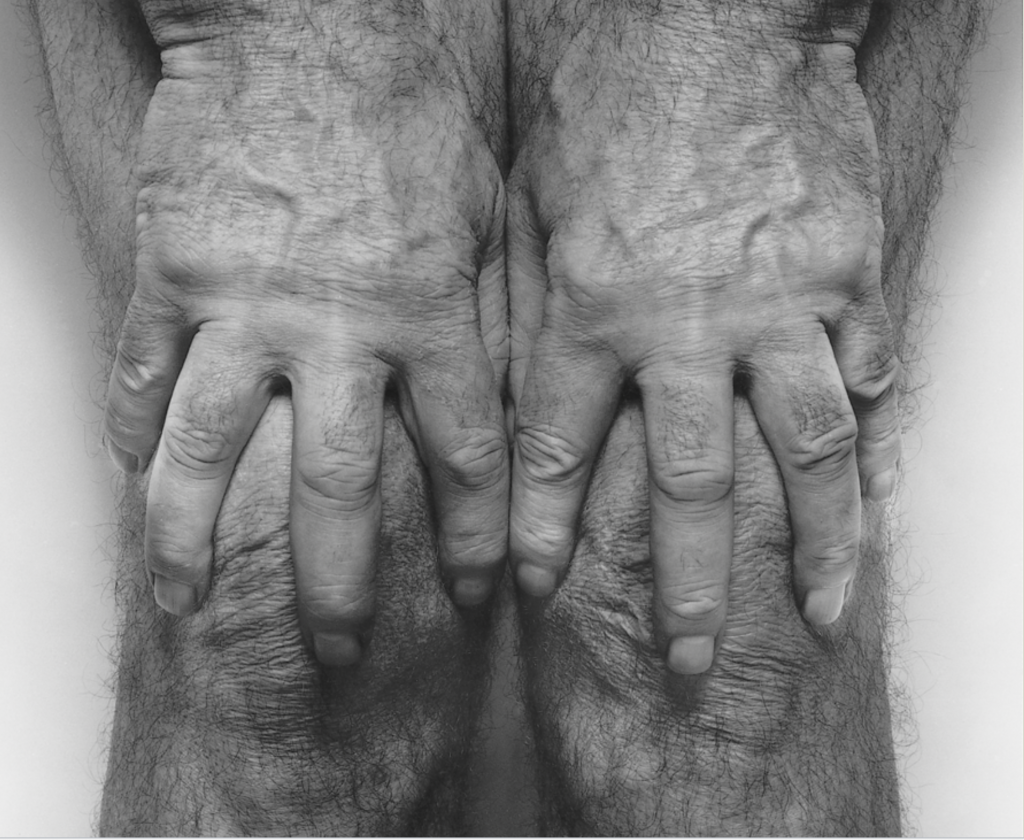
Not being there for the seminar I missed one side of the conversation but here are my initial thoughts.
The image shows a self portrait of a man of at least middle age with time showing on the skin of his hands and knees. The pose that the subject would have been in looks like a stress position that prisoners of war are sometimes tortured with. The spread hands suggest a grip on the knees to prevent the hands sliding off and a man bent over forwards to reach his knees like this.
It looks like it was taken in a studio without a cable release as his hands are visible, maybe a self timer was used or an assistant. It speaks to me of someone getting over the message of time’s impact on his body.
It’s called a self-portrait but there is no face, just a representation of a part of his body.
Alice shared a quote from Tate, (2023) “Although they are self-portraits, Coplans doesn’t show his face. Instead he focuses on isolated body parts such as hands and feet, showing them enlarged and close-up, so that they seem at once familiar and unfamiliar. Coplans’ monumental images recall classical sculpture, whilst emphasising the relentless progression of the aging process.”
Reading this it does seem to be about age and the process, whilst looking at the minutest of details that the image captures from veins, to hairs and small skin creases.
Coplans like to photograph the body in ways that generalise it and make it appear to be anybody’s body. There are no clothes so it can’t be dated and some of them are taken from a strange viewpoint as if to discombobulate the viewer.
When I mentioned earlier that he may have used an assistant to make the image, it turns out that he did. He uses assistants to do pretty much everything. He tells them what to take the photo of, how to do it, how to print it and how it’s presented. It seems a strange way to be a photographer but it obviously works for him.
He titles his images Self-Portraits and they are are portraits of him that he has directed, even if he didn’t press the shutter, control the camera or even make the prints. It shows facets of himself, if enough of these component pieces were assembled it might provide a model of the man who is the subject of these works.
Jenny Saville
The group then looked at Jenny Saville and were shown some of her work called Closed Contact (#1, #5 and #15) from 1995-1997 which appear to be herself, or another person, pressed against a piece of glass with a camera underneath. It’s very reminiscentHow does the work make you feel? Why? of the images I used to make on the photocopiers at work.
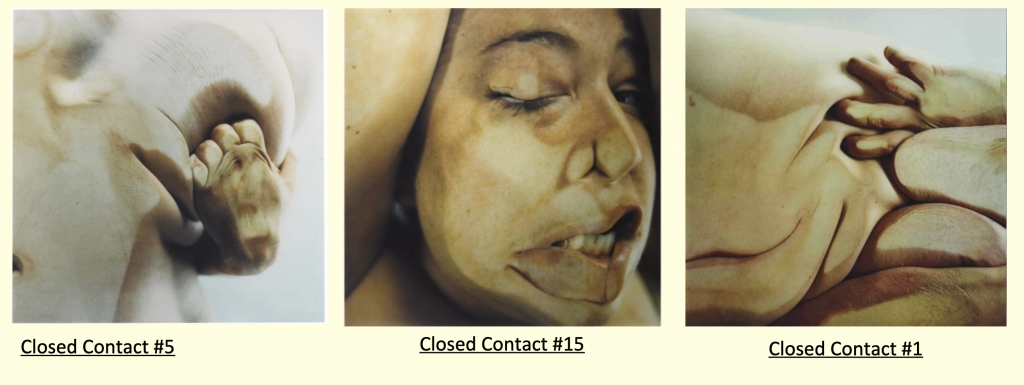
Alice posed some questions:
What is Saville trying to say in these photos? Why?
I think that she is trying to catch on film the real liquid nature of the human body. They’re a little alien in appearance and even reminded me of specimens in formaldehyde in Frankensteins lab or the killer in Silence Of The Lambs. It’s trying to portray an ugly looking side of the body and remind people that we’re all the same, nobody really looks like the ideal portrayed on Instagram etc.
How do you think these photographs were made? What materials, techniques etc. might have been employed?
I mentioned a piece of glass over a camera or maybe even a window in a wall where a body is pressed against it. It’s probably a self timer or a cable release when the artist is ready that she’s set up correctly.
How does the work make you feel? Why?
The images creep me out a little, it’s like Mrs Hudson has taken some of Sherlock Holme’s jars from the fridge to examine the contents, or even the specimen tanks for Alien Xenomorphs in Alien 3. It’s odd and uneasy but it does remind me that everyone has lumps and bumps that are usually hidden for societal acceptance when they’re what makes each of us individuals.
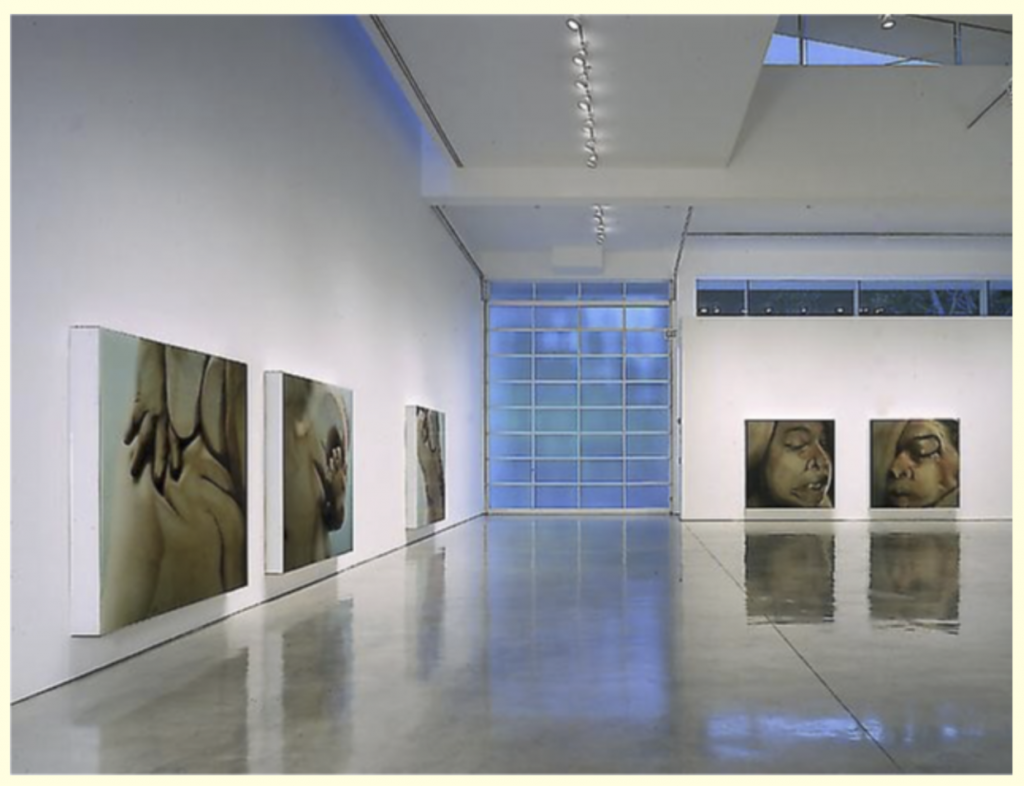
The class were then shown Propped, a self portrait that according to Sothebys “shatters canonised representations of female beauty” and this is kind of the feeling I get from the work. It’s about a woman celebrating her own body, the female form and human individuality.

Is Saville’s work relevant today?
Yes, no doubt. It’s a wake up call to all those people, who don’t feel comfortable in their own skin and idolise the people on tv, and social media. It reminds us how individual we all are and how beautiful that is as a concept. With gender fluidity and transparency, honesty and openness being high on the agenda for the younger generations this strikes me as being very relevant.
Marc Quinn
the slides then show some work by artists Marc Quinn who created some sculptures called self in different years.

To me, without reading on, they look like death masks of the same person, but they’re obviously alive. The 2001 version looks like an Ice Lolly sort of appearance whilst the others are a little clay like. They show the artist over two decades.
Ah, that’s why it looks like an ice lolly, it’s made out of the artist’s own blood and kept in that state using refrigeration equipment. These works consist of moulds made in silicone by the artist and then filling them with his own blood. These are required to be kept plugged in or they will defrost and drip down into a puddle. The notes on the slide point to him being alcohol dependent and needing to be connected to drink in the same manner that these would fall apart if they lost connection to the power.
Honestly I don’t know how I feel about this work, it’s a little out there but I admire the ingenuity of it, the fact that it could all end if there is a power cut ro a blown fuse. Some people get freaked out by it being blood but this is acceptable to me as it’s his own blood.
Photography is used in this project to take photos of the work at points in time and a timelapse could perhaps be used to see the changes in time of the way that the materials are altering. It maintains a consistent viewpoint and makes for an easy comparison of each image against the others.
Would it have the same impact if Quinn hadn’t used his own body?
If he’d used someone else’s blood or body then it might have been even weirder and difficult to justify. The fact that he’s doing this to himself allows him to maintain consistency across the decades. If the casts were made of plaster or another material then it wouldn’t have the agency of the artists blood. It could also be a material that wouldn’t matter if the power went off but the fact that it’s frozen blood makes for a jeopardy that wouldn’t exist otherwise.
Francesca Woodman
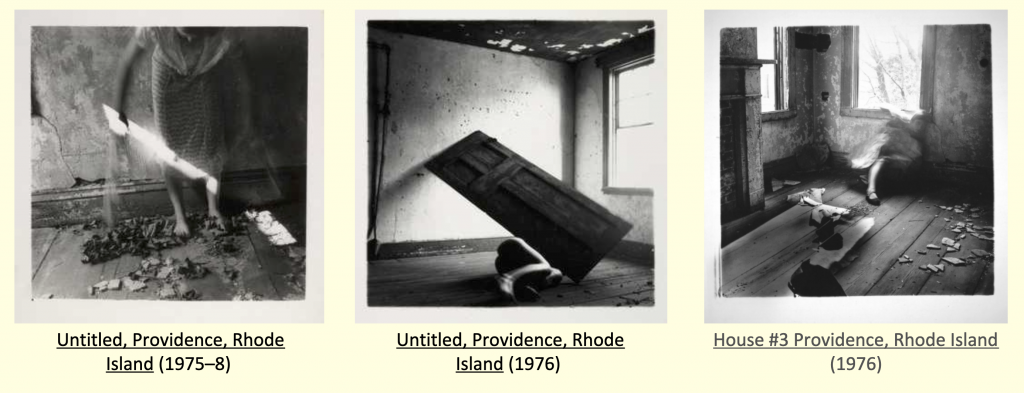
The last artist shown on the big screen in my absence was Woodman, and we’ve seen some of her work already as a number of my classmates have created work based on her previous works.
Questions displayed by Alice include:
What do you think Woodman is trying to say through the photographs you’ve analysed today?
For me the photos on the slide above are Woodman in her photos trying to be ethereal and trying to not exist in the real world, whilst also having a link to the real world. They’re very fairytale like and some are similar to ghostly images of people that have been faked over the years.
What techniques do you think she used to create the effects achieved?
It looks like tripods have been used to capture the images along with a self timer or an assistant to release the shutter once she is in position. They are also slow shutter speeds in the images as there is some motion blur from the character in the image, the background and foreground remain crisp but the figure is blurred from moving.
What feelings does the work evoke? Why?
It evokes a spooky feeling in me, like a ghost or some of them remind me of old evidence photos from police case files. In a couple of cases they also remind me of the images we used to look for in the library that showed a leg left to a burnt hole in the floor after a spontaneous human combustion event. They’re unnerving and unsettling, engaging the viewer to ask questions as to wha tis happening and why in the image. Honestly, I don’t think I could ever interpret Woodman’s photographs.
Alice’s slide contains this quote:
’Francesca Woodman’s entire body of work was produced as a young person and created over just eight short years. Her photographs explore many themes that affect young people such as relationships, sexuality, questions of self, body image, alienation, isolation and confusion or ambiguity about personal identity.’ Tate, 2023

These images all contain Woodman, and are self portraits but don’t very often make it identifiable such that the blurriness of slow speeds shows movement in very eerie ways.
They appear to be similar in appearance to some of Duane Michals work that we’ve looked at before in a surrealist fashion and use long exposures to create movement. There are also other photographers that it reminds me of but I’m unable to name them at the moment.
Alice asks us whether the fact that Woodman died young has contributed to the interest in her work? This i s probably true, people like to hear stories of mystery and tragedy, think of Kurt Cobain as a non-photographer artist who is considered in the same vein. Like Nirvana’s lyrics, Woodman’s photos are designed to confuse and put you ill at ease.
Research Task
Identify another artist/photographer who uses their own body in their work
• Choose at least one example of their work to write a short analysis and review on, support this with at least one source (minimum 400 words).
For this task I choose Vivian Maier whom I first discovered whilst listening to a song by Welsh band, Manic Street Preachers. The song Vivian appears on the the album Resistance Is Futile, 2018 , James Dean-Bradfield, lead singer, sings in the second verse “did we ever see beneath your disguise” and I think this eludes to the mysterious work and life.
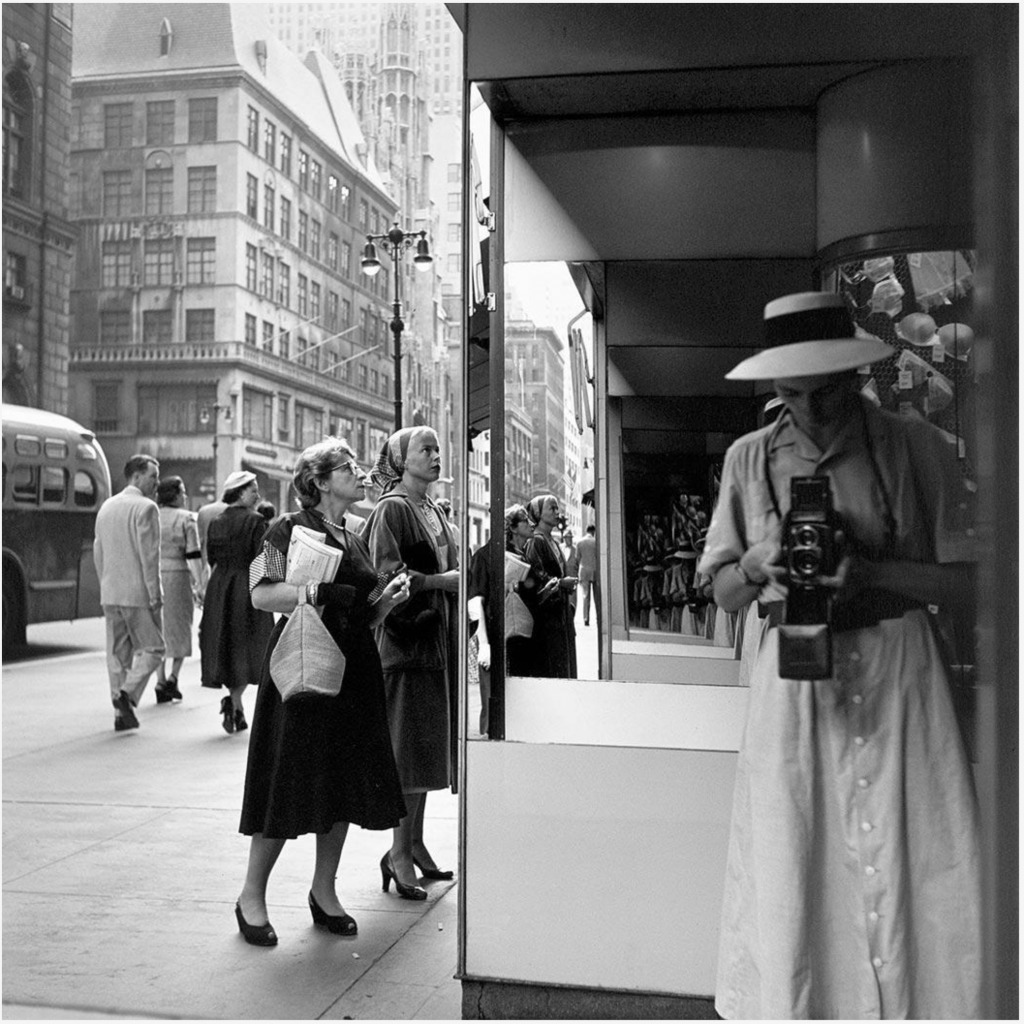
When one thinks of Maier,’s work it’s not immediately the self portraits that she crated but of the areas she wandered around in the US with her charges when she was a nanny. Looking into the collection of her work there are a number of self-portraits where she seems to be playing with reflections. Her self portraits are not usually tripod mounted and released remotely but hand held with her in the frame along with her camera at the time. In the image above we can see that she looks down into the waist level viewfinder of the twin lens reflex camera and is capturing the image of the two women perhaps looking at the underwear on display in a lingerie shop.
Maier is seemingly interested in the repetition created by the doubling up of the mirrors and how if the position is correct it can look like an infinite tunnel of the same image. It appears that the image may be of the two women but I think Maier is playing with the image of herself in the mirror behind her. She’s spotted an interesting effect and is trying to capture it on film, her own image appears around eight times in this one photograph.
It might be a comment on the fact that she is unseen by society in general and just disappears into the background of the city whilst going about her daily routine of wandering around capturing interesting scenes on film. In the Maloof documentary Finding Vivian Maier it’s said that she may not have ever planned to develop and process many of the films and photos she captured and me this image in particular feels like an experiment that she might look back on after the fact to see how it looked.
She was taking self portraits in mirrors, windows, puddles, car mirrors and chrome surfaces but the one that caught my attention in 2022 at the MK Gallery show Vivian Maier:Anthology can be seen below. It was a colour image toward the end of her hidden career as a photographer and shows her hat and coat laid out on the floor. While her body is nt in the picture, I feel that the absence of her body is what tells the story. It’s a self portrait of her after she has “left the building” to me it’s like she has shed the outfit to return to general life, or perhaps moulted the costume so she can prepare to grow into the next phase of her life.

The Hospital Visit
I started off this post with a story of having to leave to go and see my Dad in hospital. How did it end? Not well I hesitate to report.
Dad was in hospital for the week and on Saturday afternoon he died ( I don’t like using euphemisms like “passed away”) as a result of Pneumonia and Chronic Kidney failure. He was a career smoker and drinker having started both at around the age of thirteen. He continued to be alcohol dependent right up until he was loaded on the ambulance, and he often said he “didn’t drink water due to all of the chemicals in it.”
I sat in the hospital room with my brothers and family for a few days and nights and I had my camera with me all of the time. Having documented many of his ups and downs over the last 23 years, since I bought my first digital camera, I felt that I needed to complete the process. My brothers called my behaviour a little macabre when I made photographs of my Dad after he had died, even focussing on his hands which had caught my eye the week before due to looking so old and frail. “Why are you taking pictures of a dead man’s hands?” “It’s just a bit weird”
I won’t post any of these photos on the blog just yet, it’s still a little raw and it might upset some of his family and friends. I do see it being something that I can write about in the future as it’s a valuable record of the last years of his life. I will share a photo of him though as a way of remembering his smiley face in one of his most happiest of happy places.
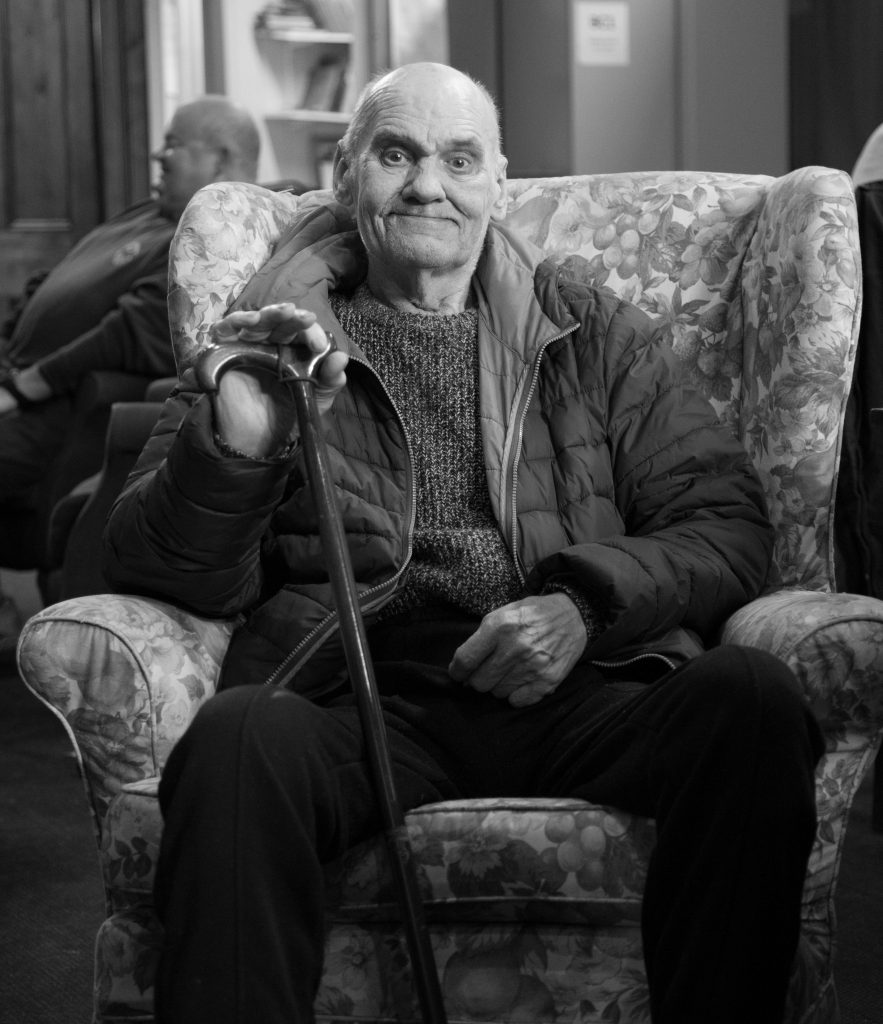
Comments are closed.